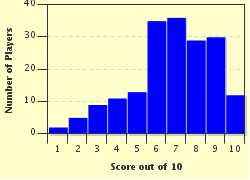Quiz Answer Key and Fun Facts
1. To be considered an autobiographical novel, a written work must be stipulated as being fiction, its protagonist must be based on the author and the main plot must mirror representative events in the author's life.
Harper Lee wrote "To Kill a Mockingbird" in 1960. Who was the narrator of the book?
2. One of the most famous autobiographical novels was written by one of the best known 19th century authors. Which eponymous novel by Charles Dickens is about Dickens himself?
3. Another 19th century classic novel that is autobiographical is "Little Women" (1867) by Louisa May Alcott. On a very superficial level, it is the story of four sisters in their transition from childhood to adulthood. Based on her own life with three sisters, which sister is the author?
4. The year is 1913. D. H. Lawrence has been described as one of the greatest writers of the 20th Century. Which of his novels, his third, was certainly autobiographical?
5. "A Farewell to Arms" (1929) is the first-person account of a young American ambulance driver serving in the Italian Campaign of World War I. The novel is one of the most well-known autobiographical novels of the 20th century. Who is the author?
6. Ray Bradbury, mystery and science fiction author of novels such as "The Martian Chronicles" (1950) and "Fahrenheit 451" (1953}, has an incongruously titled novel in his bibliography called "Dandelion Wine" (1957). This novel is a departure from his regular novels. Is it a semi-autobiographical novel based on his teenage years attempting to make wine in his parents' garage in Illinois?
7. Sylvia Plath was a renowned American poet who was plagued throughout her life with depression. Her only novel was published under a Victoria Lucas pseudonym in 1963, a month before she committed suicide aged 30. What was the name of the novel?
8. The non-fiction novel, sometimes coined "faction", is a genre that needs to be distinguished from the autobiographical novel. The genre was established in 1965 when Truman Capote and Harper Lee interviewed the suspects of the Kansas Clutter Family murders. Capote wrote a novel from those interviews. What was the name of Capote's book?
9. Another literary device similar to the autobiographical novel is the Roman à clef. This is a novel about actual events but with a layer of fiction superimposed on it. The characters are fictitious but represent real people. In 1996 an anonymous author published "Primary Colors". What was the story-line of this controversial novel?
10. Can a science fiction author write a book which is autobiographical? While there is debate about the definition about what constitutes science fiction, there appears to be consensus that such fiction depicts futuristic settings. In 1963 Arthur C. Clarke, one of the greatest scientific fiction writers of all time, wrote "Glide Path" which he claims is semi-autobiographical. How is this possible?
Source: Author
1nn1
This quiz was reviewed by FunTrivia editor
looney_tunes before going online.
Any errors found in FunTrivia content are routinely corrected through our feedback system.

